Evaluation of Steel Slag Optimal Replacement in Asphalt Mixture under Microwave Heating Based on 3D Polyhedral Aggregate Electromagnetic-Thermal Meso-Model
Abstract
1. Introduction
2. Basic Assumptions
- Aggregate with a particle size below 4.75 (mm), fine mineral powder as filler, and asphalt binder are homogenized into a uniform asphalt mortar. This simplification is reasonable since this mesoscopic model, based on polyhedral aggregates, already has high accuracy.
- To reduce the complexity of the calculation, we assume aggregate shapes can be treated as convex polyhedrons (hereafter referred to as polyhedrons). Despite the deviation of this assumption from reality, polyhedral aggregate still presents a much better approximation to the actual shapes of aggregate than mesoscale models based on spherical aggregate.
- The physical and chemical properties of the constituents in the specimen are kept constant, and the variations of these properties can be assumed to be negligible over a relatively small temperature range, so these are assumed to be constant in the model.
- We neglect voids in the mesoscopic scale of the asphalt mixture because the void ratio of an AC-type mix is small, usually below 4%.
- We treat the inner heat transfer of the components of the asphalt mixture specimen as perfect and ideal conditions, with no heat loss occurring during internal transfer, i.e., no consideration is made of the interface of thermal resistance.
3. Microwave Heating Model
3.1. Meso-Random Geometry Model
- Random growth algorithm for aggregates. Firstly, we generate those spheres with the desired probability distribution, based on the modified Monte Carlo method proposed in our previous study [23], then, we generate elementary octahedral aggregates based on spheres. Four points of the octahedral aggregate are located on the horizontal plane of the sphere, and the other two points are located on the upper and lower sphere surfaces. Next, we search the longest side of the aggregate and expand it outward. After some 3D expansion, we connect all the edges and generate a polyhedral aggregate particle. This method can improve the selection of growing edges: it selects the sub-length edges to grow when the current edge is unable to keep growing and avoids a situation wherein the longest edge cannot grow.
- Random placement method, based on the GJK algorithm. We arrange all the generated aggregate geometry information from smallest to largest, then convert two convex hulls into a configuration space via Minkowski difference [24,25]. Subsequently, we transform the distance between two convex hulls into the distance between the configuration space. In the case that the nearest distance is greater than 0, it proves that the two aggregates are separated. When the nearest distance is equal to 0, it means that the edges of the two aggregates are coincident, while in the case that the nearest distance does not exist, the partial areas of the two objects overlap. Therefore, the random placement of aggregates is realized according to the distance between the two polyhedrons. Besides, this algorithm can achieve the random placement of a relatively high aggregate volume ratio, based on the given gradation.
3.2. Governing Equation
3.2.1. Electromagnetic Field
3.2.2. Temperature Field
3.2.3. Boundary Conditions
4. Simulation Method
4.1. Finite Element Model
4.2. Material Properties
4.3. Random Selection
5. Model Validation from Experiment and Shape Effect
6. Results and Discussions
6.1. Effect of Different Particle Sizes of Steel Slag Contents on the Volume Average Temperature
6.2. Effect of Steel Slag Contents of Asphalt Mixtures on Microwave Absorption Capacity
6.2.1. Electromagnetic Field and Heat Source Distribution of Asphalt Mixtures with Polyhedral Steel Slag
6.2.2. Microwave Heating Efficiency Analysis and Optimal Replacement Rate Mechanism
6.3. Influence of Steel Slag Content on Temperature Distribution
6.3.1. Variation of Temperature Distribution in the Center Section
6.3.2. Internal Temperature Gradients of Steel Slag Asphalt Mixtures
7. Conclusions
- The algorithm for random growth and placement that is presented in this paper can generate a polyhedral aggregate model with a high volume ratio. The details of the internal temperature and electromagnetic fields of the asphalt mixture during microwave heating can be effectively described by the 3D mesoscale model that has been developed. The shape of the aggregate (sphere and polyhedron) has little effect on the uniformity of heat transfer within the asphalt mixture. The steel slag asphalt mixture’s surface temperature values accord well with the reported experimental findings, which demonstrates the validity of the model.
- When the steel slag replacement rate is 60% in both the 4.75–9.5 mm and 9.5–13.2 mm particle size intervals, the volume average temperature of the asphalt mixture is the closest to the optimal healing temperature, and the temperature distribution of the asphalt mixture is the most uniform. In particular, the temperature gradient around the boundary of the steel slag is the highest. The heat transfer is more uniform for the 4.75–9.5 mm steel slag compared to the 9.5–13.2 mm steel slag.
- The electromagnetic field of the asphalt mixture exhibits a specific oscillation pattern under microwave radiation. In addition, the dielectric constant, permeability, and particle size of steel slag may affect the properties of microwave reflection. Too much steel slag will increase the impedance of the specimen and hinder the absorption of microwaves.
Author Contributions
Funding
Institutional Review Board Statement
Informed Consent Statement
Data Availability Statement
Conflicts of Interest
References
- Yang, H.; Ouyang, J.; Jiang, Z.; Ou, J. Effect of fiber reinforcement on self-healing ability of asphalt mixture induced by microwave heating. Constr. Build. Mater. 2023, 362, 129701. [Google Scholar] [CrossRef]
- Li, P.; Wang, Z.; Men, B.; Ma, X.; Tang, G.; Wang, R. Use of Multi-Scale Investigation to Evaluate Adhesion Performance of Warm-Mix Polymer-Modified Asphalt. Materials 2023, 16, 287. [Google Scholar] [CrossRef]
- Schuster, L.; Staub de Melo, J.V.; Villena Del Carpio, J.A. Effects of the associated incorporation of steel wool and carbon nanotube on the healing capacity and mechanical performance of an asphalt mixture. Int. J. Fatigue 2023, 168, 107440. [Google Scholar] [CrossRef]
- Sun, D.; Sun, G.; Zhu, X.; Ye, F.; Xu, J. Intrinsic temperature sensitive self-healing character of asphalt binders based on molecular dynamics simulations. Fuel 2018, 211, 609–620. [Google Scholar] [CrossRef]
- Gulisano, F.; Gallego, J. Microwave heating of asphalt paving materials: Principles, current status and next steps. Constr. Build. Mater. 2021, 278, 121993. [Google Scholar] [CrossRef]
- Ukwuoma, O.; Ademodi, B. The effects of temperature and shear rate on the apparent viscosity of Nigerian oil sand bitumen. Fuel Process. Technol. 1999, 60, 95–101. [Google Scholar] [CrossRef]
- Little, D.N.; Bhasin, A. Exploring mechanisms of healing in asphalt mixtures and quantifying its impact. In Self Healing Materials an Alternative Approach to 20 Centuries of Materials Science; Springer Series in Materials Science; Springer: Dordrecht, The Netherlands, 2007; Volume 100, pp. 205–218. [Google Scholar]
- Liu, Q.; Schlangen, E.; van de Ven, M.; van Bochove, G.; van Montfort, J. Evaluation of the induction healing effect of porous asphalt concrete through four point bending fatigue test. Constr. Build. Mater. 2012, 29, 403–409. [Google Scholar] [CrossRef]
- Liu, Q.; Schlangen, E.; García, Á.; van de Ven, M. Induction heating of electrically conductive porous asphalt concrete. Constr. Build. Mater. 2010, 24, 1207–1213. [Google Scholar] [CrossRef]
- Gallego, J.; del Val, M.A.; Contreras, V.; Páez, A. Heating asphalt mixtures with microwaves to promote self-healing. Constr. Build. Mater. 2013, 42, 1–4. [Google Scholar] [CrossRef]
- Norambuena-Contreras, J.; Garcia, A. Self-healing of asphalt mixture by microwave and induction heating. Mater. Des. 2016, 106, 404–414. [Google Scholar] [CrossRef]
- Gao, J.; Sha, A.; Wang, Z.; Tong, Z.; Liu, Z. Utilization of steel slag as aggregate in asphalt mixtures for microwave deicing. J. Clean. Prod. 2017, 152, 429–442. [Google Scholar] [CrossRef]
- Benedetto, A.; Calvi, A. A pilot study on microwave heating for production and recycling of road pavement materials. Constr. Build. Mater. 2013, 44, 351–359. [Google Scholar] [CrossRef]
- Joenck, F.T.; Joenck, V.B.C.; Villena Del Carpio, J.A.; Staub de Melo, J.V. Self-healing capacity of asphalt mixtures with steel fiber, steel slag and graphite powder, evaluated with microwave induction and fatigue test. Matéria 2022, 27, e20220221. [Google Scholar] [CrossRef]
- Liu, Z.; Yang, X.; Wang, Y.; Luo, S. Engineering properties and microwave heating induced ice-melting performance of asphalt mixture with activated carbon powder filler. Constr. Build. Mater. 2019, 197, 50–62. [Google Scholar] [CrossRef]
- Wang, R.; Xiong, Y.; Ma, X.; Guo, Y.; Yue, M.; Yue, J. Investigating the differences between steel slag and natural limestone in asphalt mixes in terms of microscopic mechanism, fatigue behavior and microwave-induced healing performance. Constr. Build. Mater. 2022, 328, 127107. [Google Scholar] [CrossRef]
- Liu, J.; Wang, Z.; Guo, H.; Yan, F. Thermal transfer characteristics of asphalt mixtures containing hot poured steel slag through microwave heating. J. Clean. Prod. 2021, 308, 127225. [Google Scholar] [CrossRef]
- Pathak, S.; Choudhary, R.; Kumar, A. Investigation of moisture damage in open graded asphalt friction course mixtures with basic oxygen furnace steel slag as coarse aggregate under acidic and neutral pH environments. Transp. Res. Rec. 2020, 2674, 887–901. [Google Scholar] [CrossRef]
- Wen, H.; Wu, S.; Bhusal, S. Performance evaluation of asphalt mixes containing steel slag aggregate as a measure to resist studded tire wear. J. Mater. Civ. Eng. 2016, 28, 04015191. [Google Scholar] [CrossRef]
- Lou, B.; Sha, A.; Li, Y.; Wang, W.; Liu, Z.; Jiang, W.; Cui, X. Effect of metallic-waste aggregates on microwave self-healing performances of asphalt mixtures. Constr. Build. Mater. 2020, 246, 118510. [Google Scholar] [CrossRef]
- Chen, X.; Wang, Y.; Liu, Z.; Dong, Q.; Zhao, X. Temperature analyses of porous asphalt mixture using steel slag aggregates heated by microwave through laboratory tests and numerical simulations. J. Clean. Prod. 2022, 338, 130614. [Google Scholar] [CrossRef]
- Liu, Y.; Ye, Y.; Luo, W.; Peng, H. Modeling the Behavior of an Aggregate Skeleton during Static Creep of an Asphalt Mixture Based on a Three-Dimensional Mesoscale Random Model. J. Mater. Civ. Eng. 2022, 34, 04022319. [Google Scholar] [CrossRef]
- Luo, W.; Huang, S.; Liu, Y.; Peng, H.; Ye, Y. Three-dimensional mesostructure model of coupled electromagnetic and heat transfer for microwave heating on steel slag asphalt mixtures. Constr. Build. Mater. 2022, 330, 127235. [Google Scholar] [CrossRef]
- Feng, Y.; Tan, Y. On Minkowski difference-based contact detection in discrete/discontinuous modelling of convex polygons/polyhedra: Algorithms and implementation. Eng. Comput. 2019, 37, 54–72. [Google Scholar] [CrossRef]
- Montanari, M.; Petrinic, N.; Barbieri, E. Improving the GJK algorithm for faster and more reliable distance queries between convex objects. ACM Trans. Graph. (TOG) 2017, 36, 30. [Google Scholar] [CrossRef]
- Lou, B.; Sha, A.; Barbieri, D.M.; Liu, Z.; Zhang, F. Microwave heating properties of steel slag asphalt mixture using a coupled electromagnetic and heat transfer model. Constr. Build. Mater. 2021, 291, 123248. [Google Scholar] [CrossRef]
- Hong, Y.; Lin, B.; Li, H.; Dai, H.; Zhu, C.; Yao, H. Three-dimensional simulation of microwave heating coal sample with varying parameters. Appl. Therm. Eng. 2016, 93, 1145–1154. [Google Scholar] [CrossRef]
- Phan, T.M.; Park, D.W.; Le, T.H.M. Crack healing performance of hot mix asphalt containing steel slag by microwaves heating. Constr. Build. Mater. 2018, 180, 503–511. [Google Scholar] [CrossRef]
- Norambuena-Contreras, J.; Gonzalez-Torre, I. Influence of the Microwave Heating Time on the Self-Healing Properties of Asphalt Mixtures. Appl. Sci. 2017, 7, 1076. [Google Scholar] [CrossRef]
- Ma, Z.; Cao, C.T.; Liu, Q.F.; Wang, J.B. A new method to calculate the degree of electromagnetic impedance matching in one-layer microwave absorbers. Chin. Phys. Lett. 2012, 29, 038401. [Google Scholar] [CrossRef]
- Wang, H.; Yang, J.; Lu, G.; Liu, X. Accelerated Healing in Asphalt Concrete via Laboratory Microwave Heating. J. Test. Eval. 2018, 48, 739–757. [Google Scholar] [CrossRef]
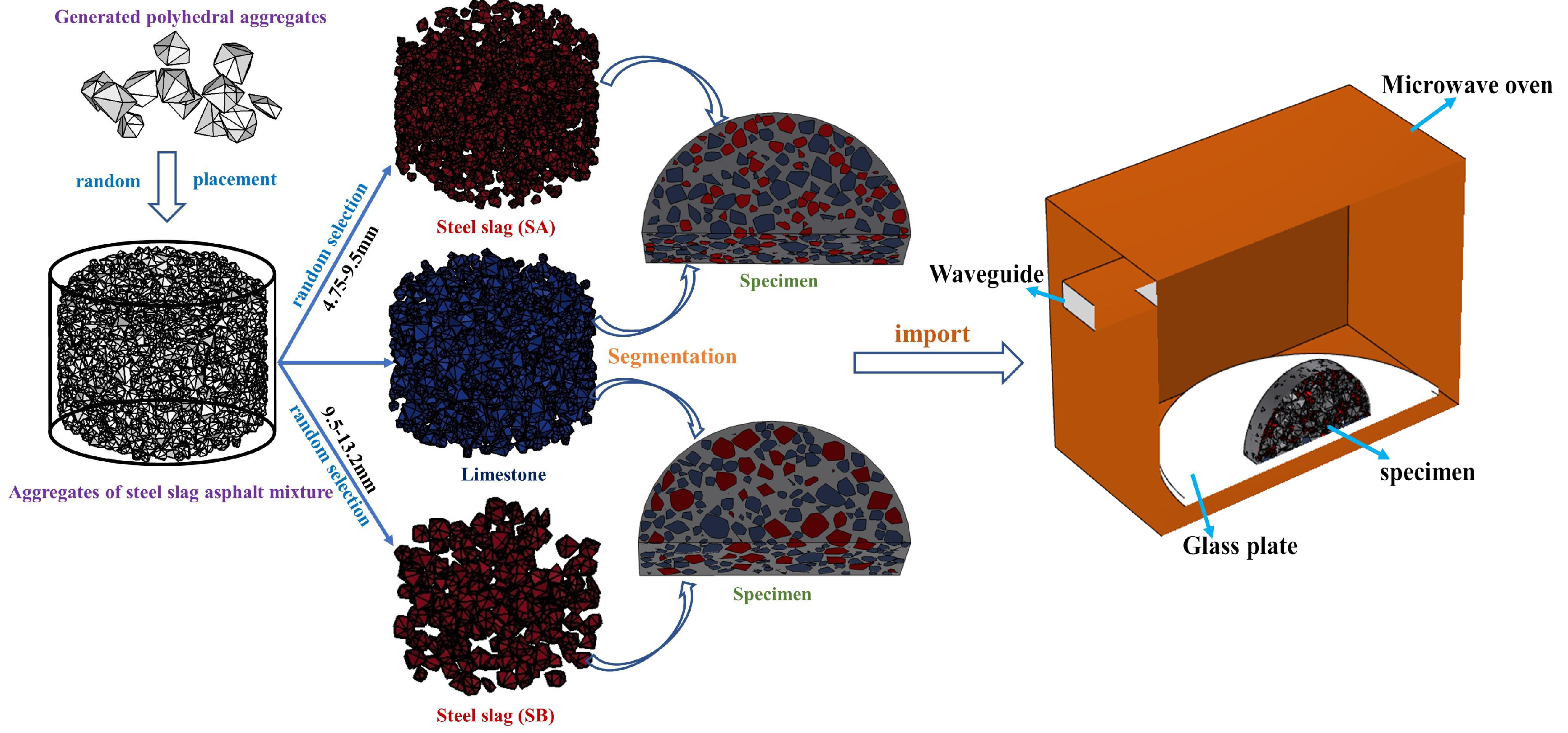


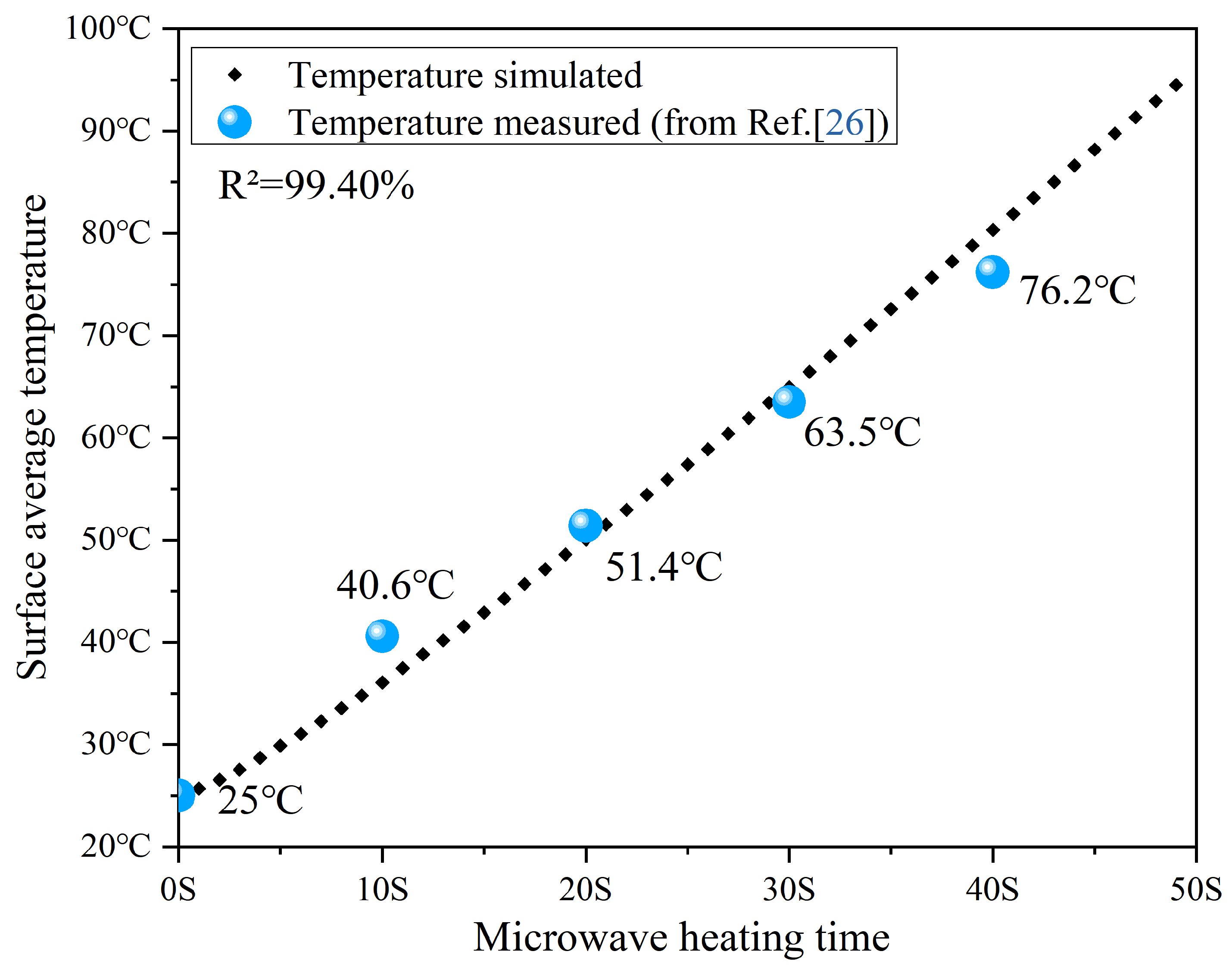
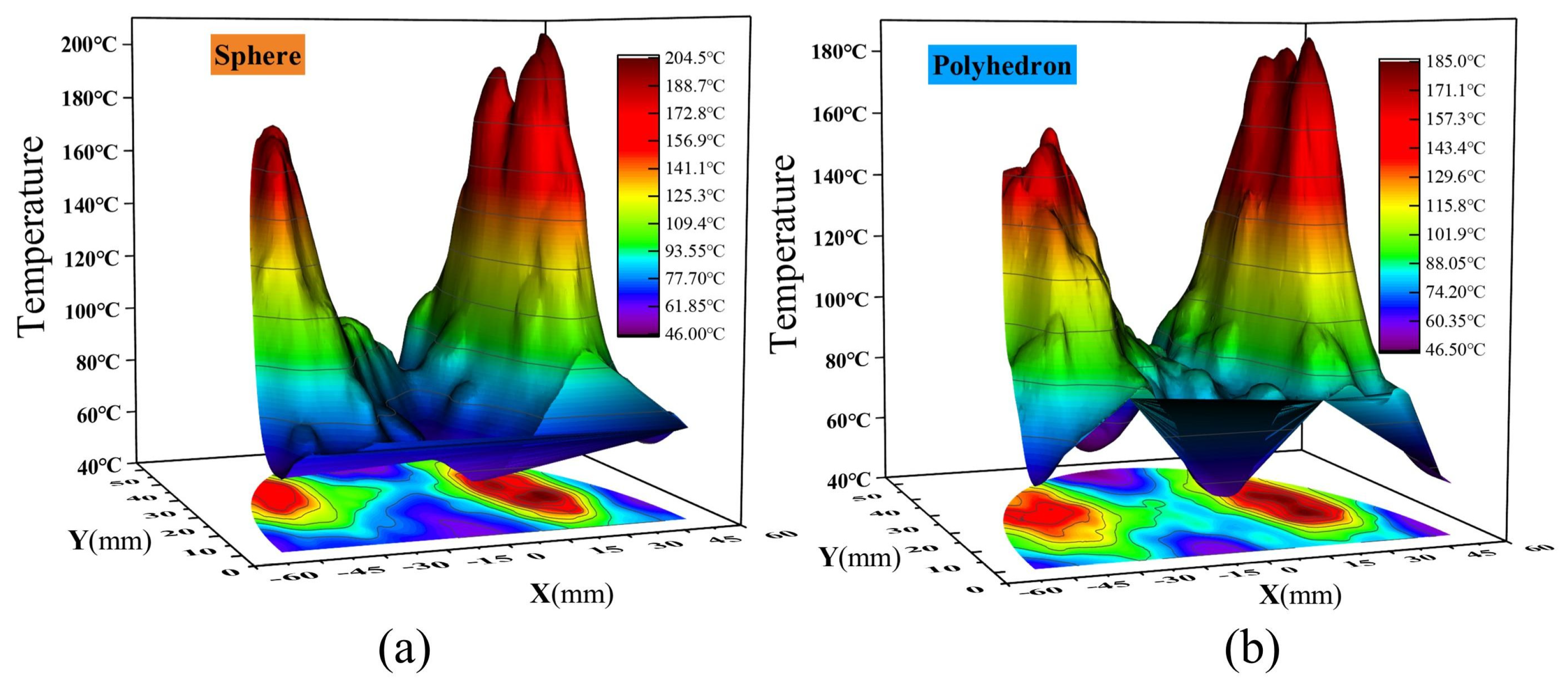
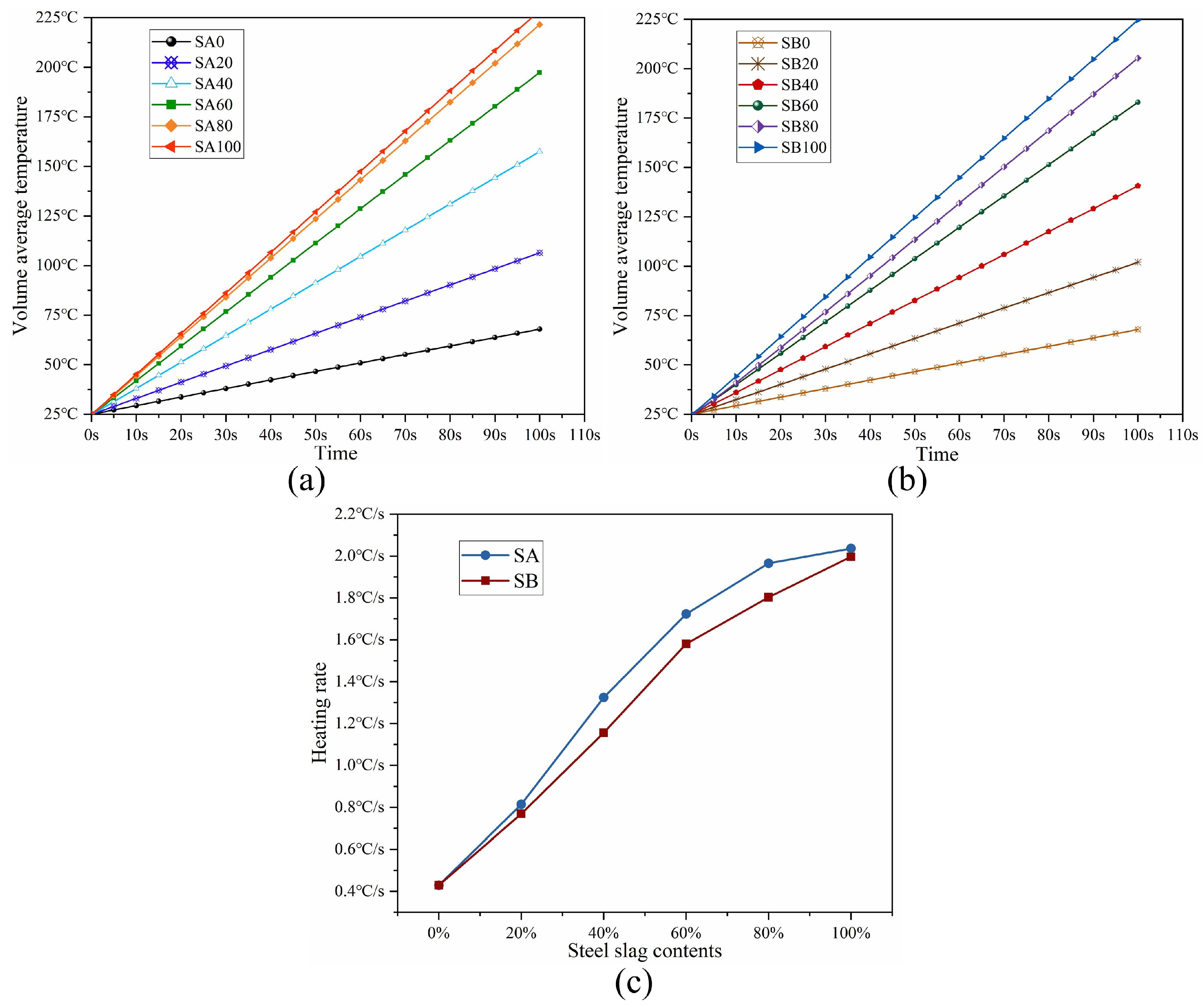
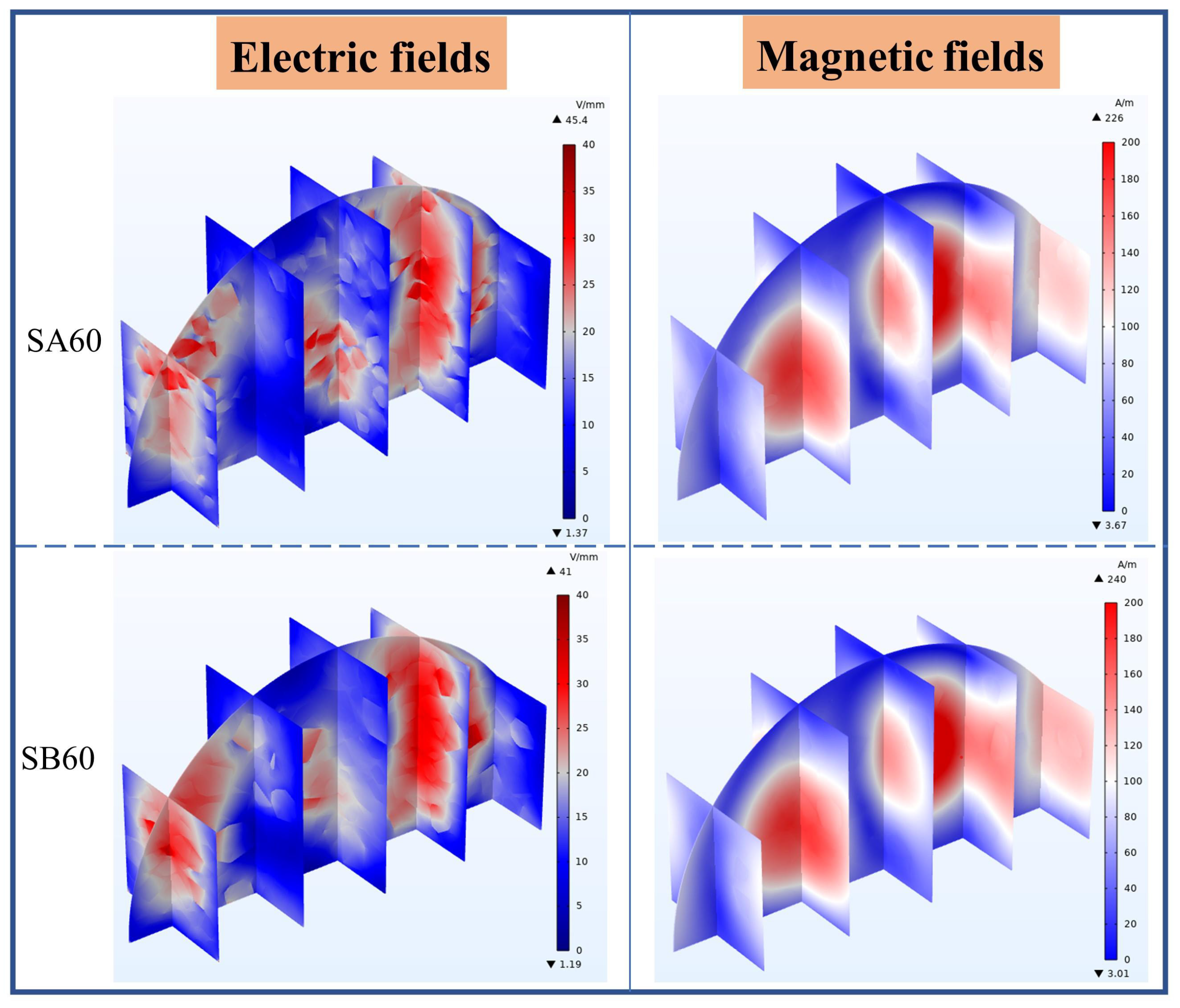
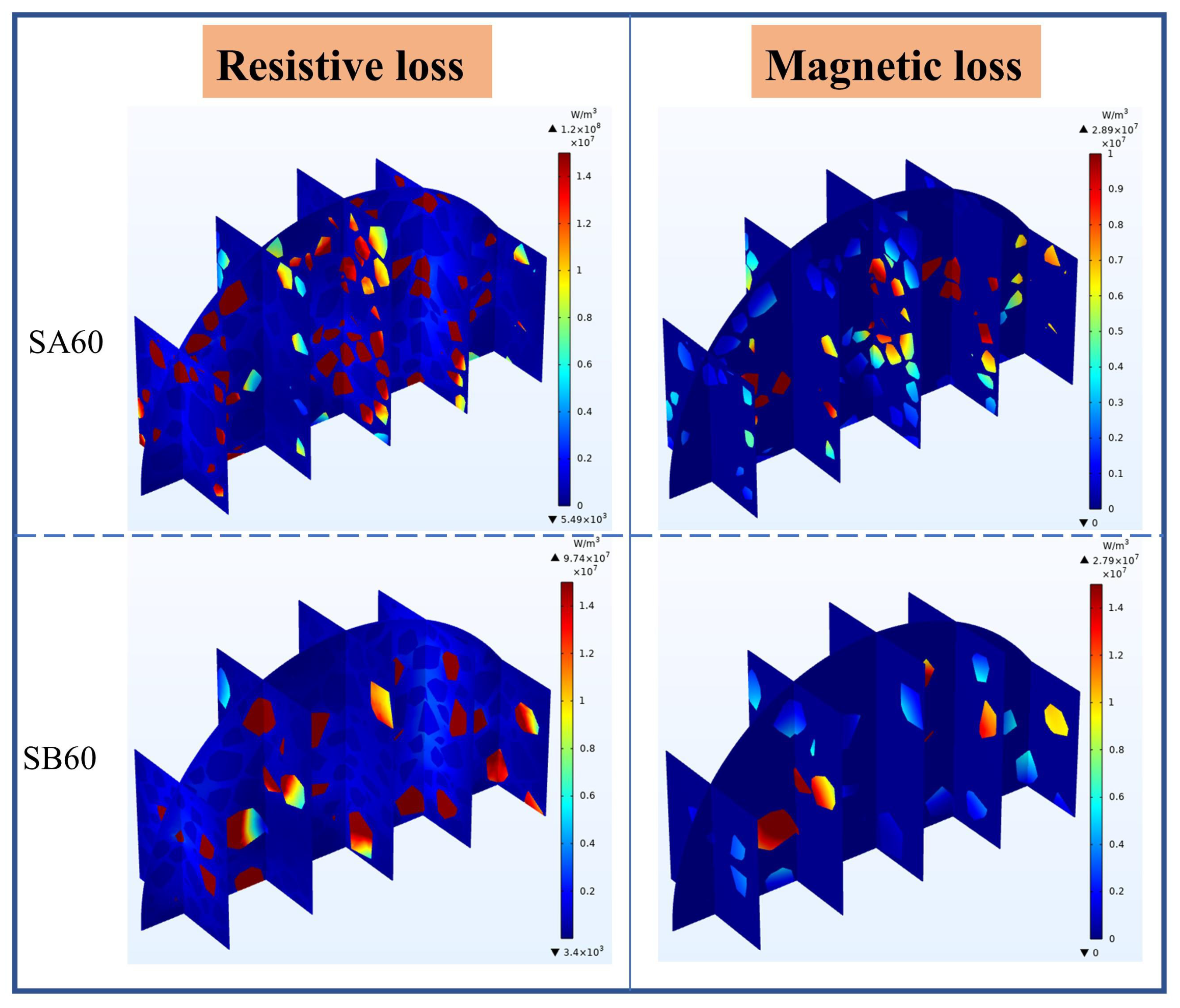
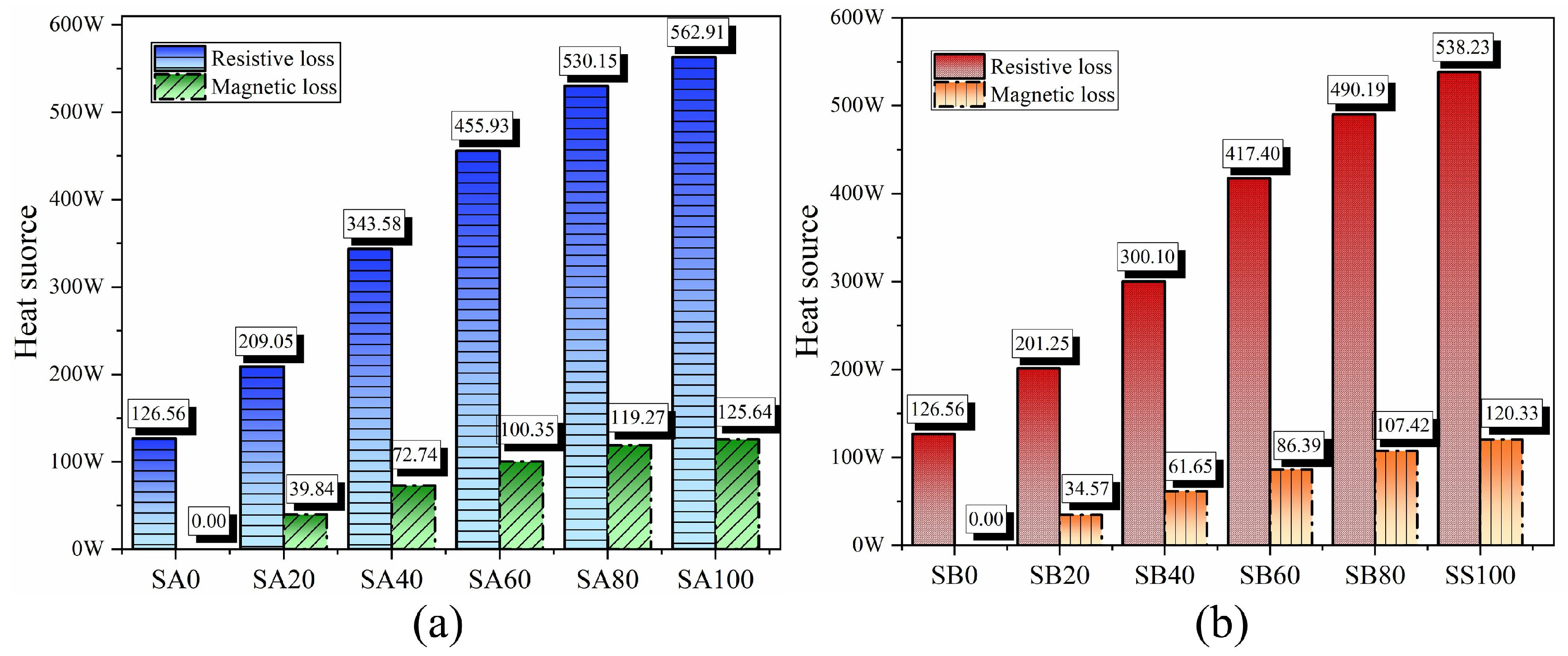
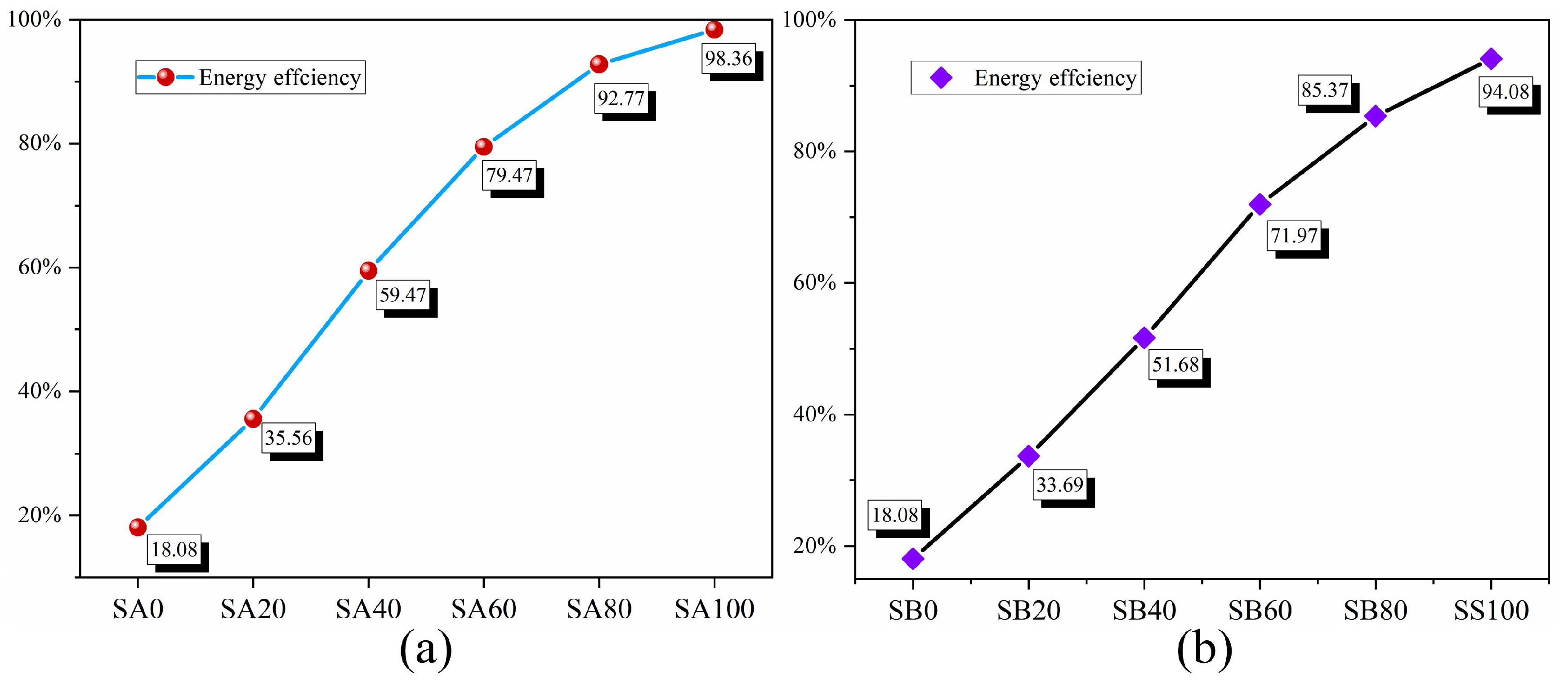
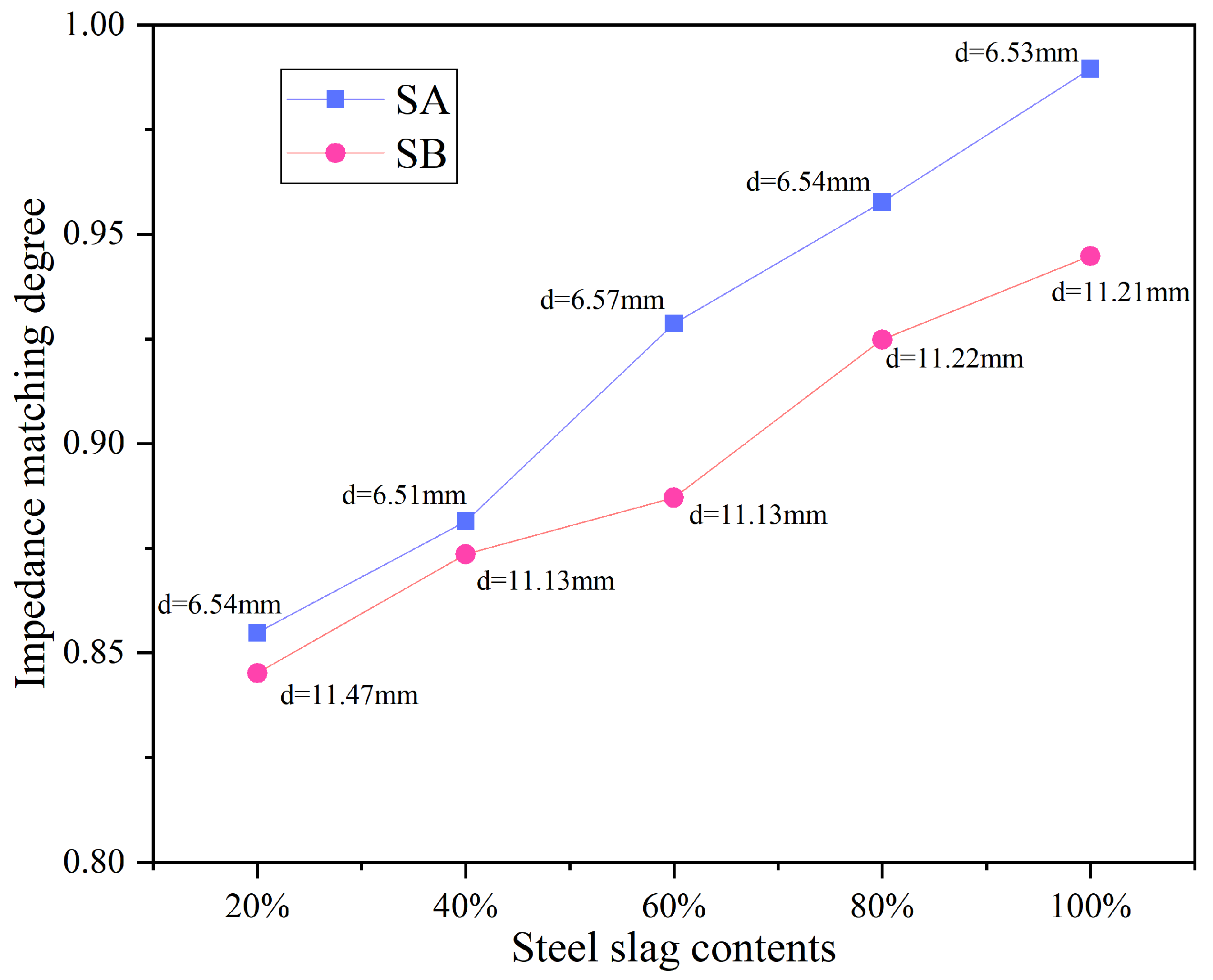
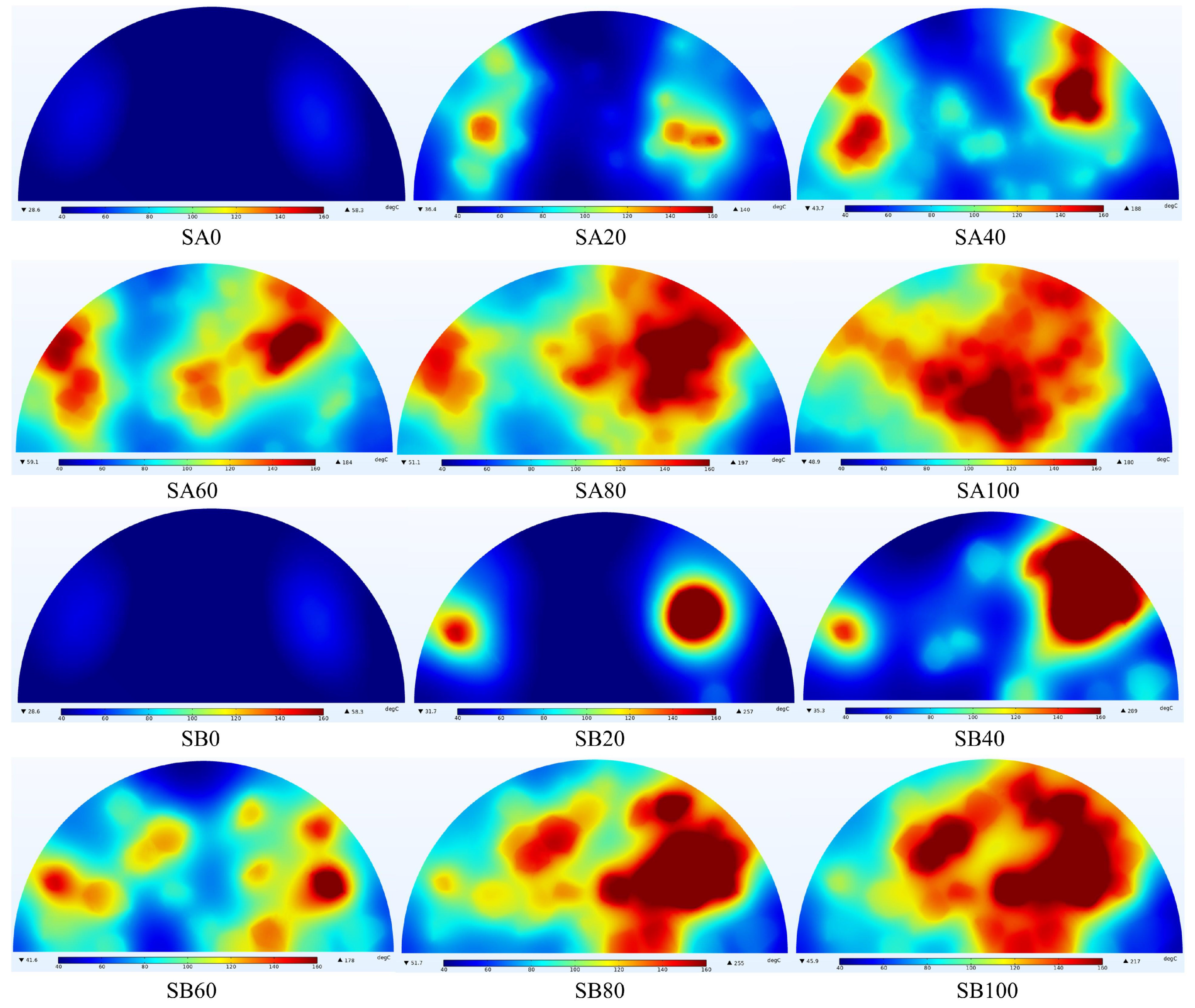
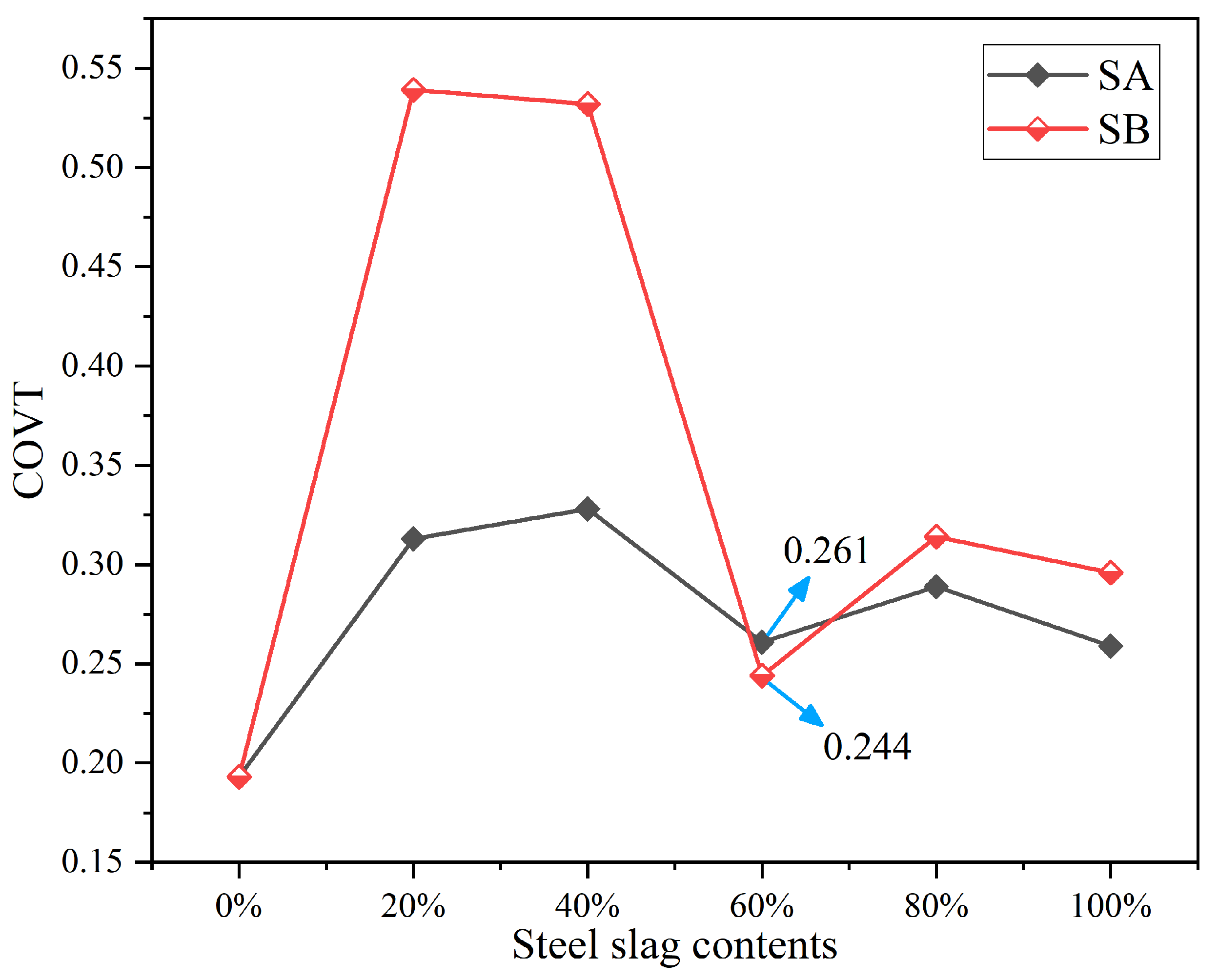
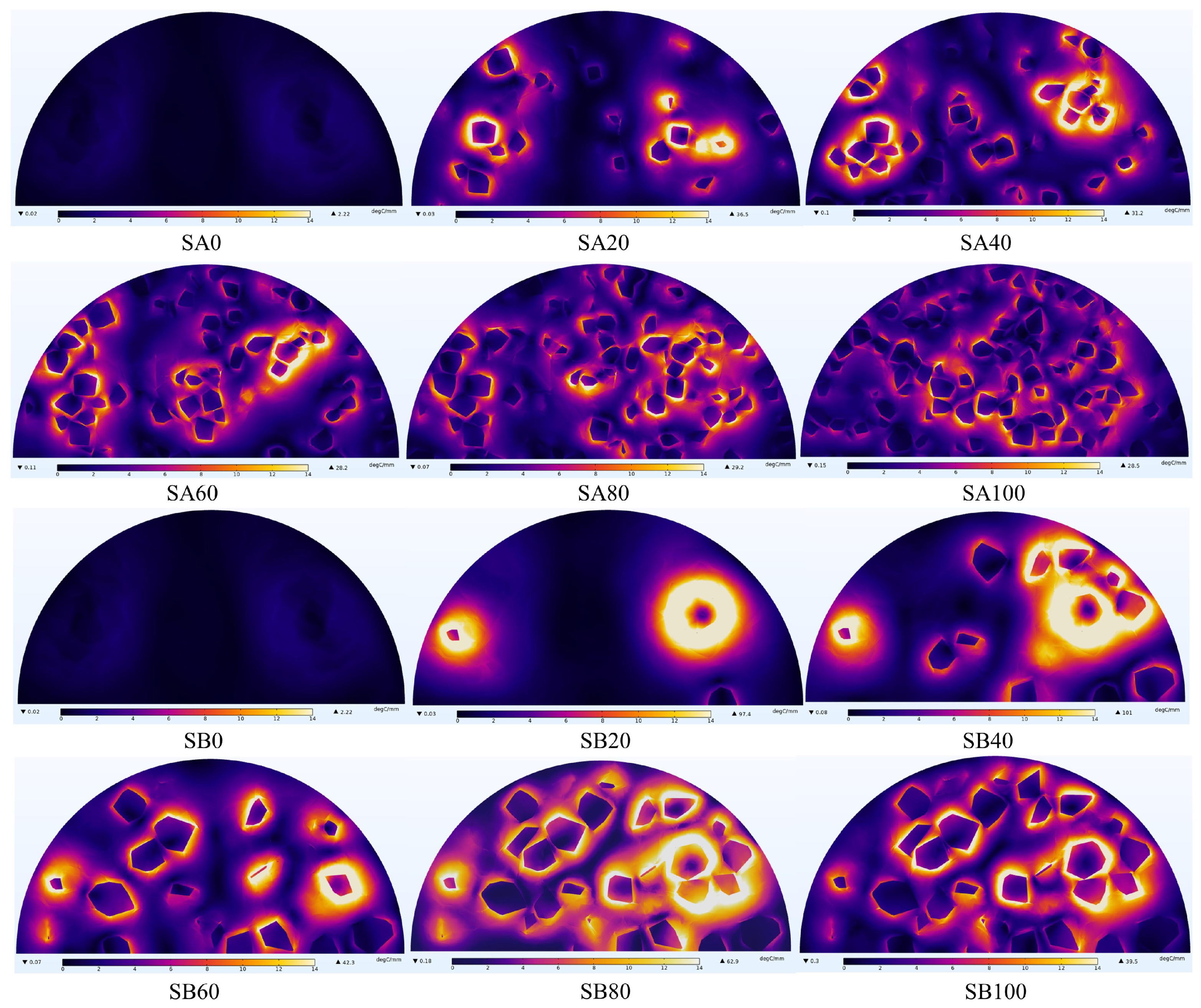
| Component | Density (kg/m3) | Thermal Conductivity (W/(m·°C)) | Specific Heat Capacity (J/(kg·°C)) | Electrical Conductivity (S/m) | Relative Complex Permittivity |
|---|---|---|---|---|---|
| Asphalt mortar | 2550.36 | 3.055 | 867.72 | 0.002 | 6.5–0.028 *j |
| Replacement Ratio | With a Particle Size of 4.75–9.5 mm | With a Particle Size of 9.5–13.2 mm |
|---|---|---|
| 0% | SA0 | SB0 |
| 20% | SA20 | SB20 |
| 40% | SA40 | SB40 |
| 60% | SA60 | SB60 |
| 80% | SA80 | SB80 |
| 100% | SA100 | SB100 |
Disclaimer/Publisher’s Note: The statements, opinions and data contained in all publications are solely those of the individual author(s) and contributor(s) and not of MDPI and/or the editor(s). MDPI and/or the editor(s) disclaim responsibility for any injury to people or property resulting from any ideas, methods, instructions or products referred to in the content. |
© 2023 by the authors. Licensee MDPI, Basel, Switzerland. This article is an open access article distributed under the terms and conditions of the Creative Commons Attribution (CC BY) license (https://creativecommons.org/licenses/by/4.0/).
Share and Cite
Huang, S.; Ye, Y.; Liu, Y.; Zheng, B.; Luo, W. Evaluation of Steel Slag Optimal Replacement in Asphalt Mixture under Microwave Heating Based on 3D Polyhedral Aggregate Electromagnetic-Thermal Meso-Model. Coatings 2023, 13, 517. https://doi.org/10.3390/coatings13030517
Huang S, Ye Y, Liu Y, Zheng B, Luo W. Evaluation of Steel Slag Optimal Replacement in Asphalt Mixture under Microwave Heating Based on 3D Polyhedral Aggregate Electromagnetic-Thermal Meso-Model. Coatings. 2023; 13(3):517. https://doi.org/10.3390/coatings13030517
Chicago/Turabian StyleHuang, Siyang, Yong Ye, Yuhong Liu, Baojing Zheng, and Wei Luo. 2023. "Evaluation of Steel Slag Optimal Replacement in Asphalt Mixture under Microwave Heating Based on 3D Polyhedral Aggregate Electromagnetic-Thermal Meso-Model" Coatings 13, no. 3: 517. https://doi.org/10.3390/coatings13030517
APA StyleHuang, S., Ye, Y., Liu, Y., Zheng, B., & Luo, W. (2023). Evaluation of Steel Slag Optimal Replacement in Asphalt Mixture under Microwave Heating Based on 3D Polyhedral Aggregate Electromagnetic-Thermal Meso-Model. Coatings, 13(3), 517. https://doi.org/10.3390/coatings13030517





